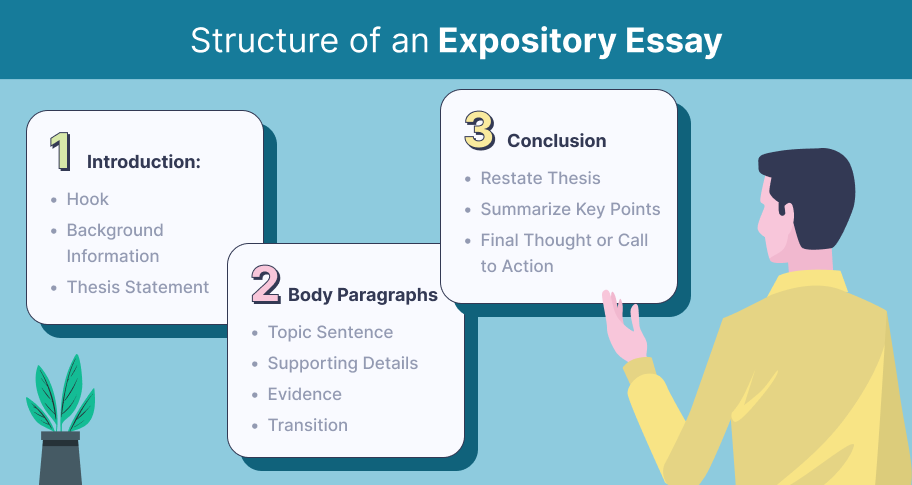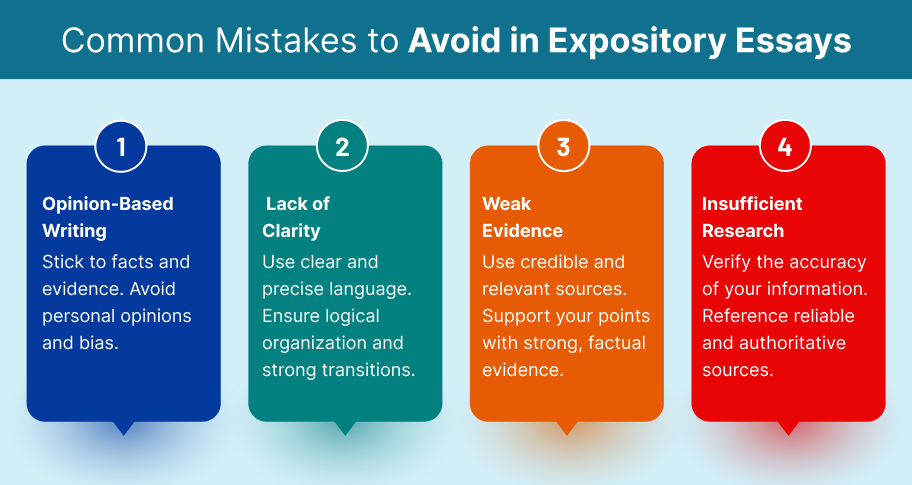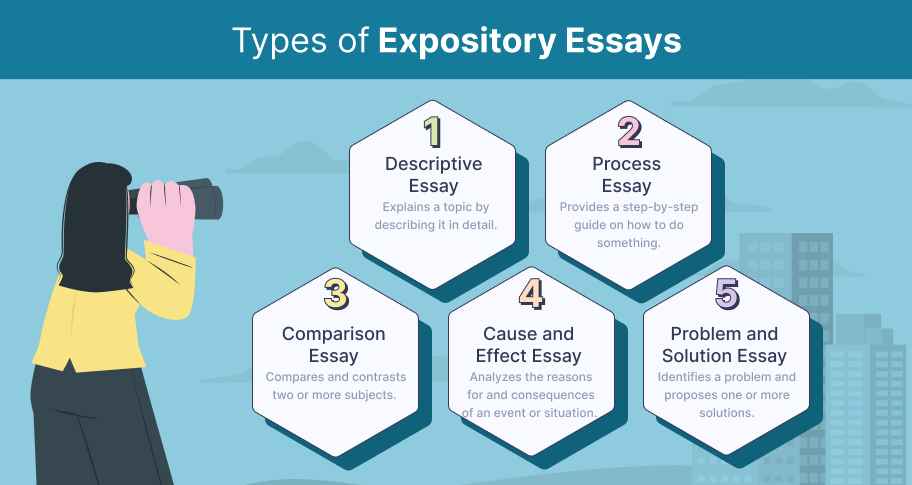Introduction
“Just the facts, ma’am.” Remember that line? It’s a catchphrase attributed to Joe Friday from the old show Dragnet. But it perfectly sums up what it means to write an expository essay.
Teachers often assign expository essays to assess a student’s learning on a subject. The term “expository” means to expose, expound, or explain. When you write an expository essay, you are exposing the main ideas of a subject, elaborating on it, or explaining the meaning of it in some detail.
So, what’s an expository essay?
An expository essay is a structured essay that informs the reader about something, explains something, or describes something—and it does so with perfect clarity and precision.
In this article, we’ll look at the definition, types, structure, writing tips, and common mistakes associated with writing an expository essay. We’ll also give some practical examples and answer those frequently asked questions students tend to have when tasked with this kind of writing.
Let’s begin.
What is an Expository Essay?
An expository essay is a genre of writing that explores and explains a specific topic in a logical and straightforward manner.
The main goals of expository writing are to inform the reader, explain a subject, or describe a topic in a way that is accessible and comprehensible. You’re not trying to confuse or overwhelm a reader with all of your vast knowledge. You’re trying to illuminate and help the reader.
An expository essay is different from a persuasive or argumentative essay. The latter may draw on emotional appeals to make a point. Expository writing relies solely on facts and nothing but.
Although an expository essay might involve some research or reference to outside sources, it is also different from a research paper. The goal is bring a subject into relief in a simple but effective way.
When you write an expository essay, pretend you are a teacher. Your goal is to inform the reader by providing facts about a subject or explaining its importance or meaning. An expository essay can be about literature, the arts, history, business, or religion—almost anything, really.
Types of Expository Essays
| Type of Expository Essay | Description | Example 1 | Example 2 |
|---|---|---|---|
| Classification Essays | Organizes and categorizes subjects into different groups. | An essay that explains the classifications of art movements over the centuries. | An essay categorizing types of social media platforms. |
| Definition Essays | Clarifies the meaning of a term or concept. | An essay that defines the concept of gender through the lens of feminism. | An essay defining the term artificial intelligence. |
| Process Essays | Explains the steps involved in a process. | An essay that explains the supply chain process in manufacturing a Tesla. | An essay describing the process of making homemade bread. |
| Compare-and-Contrast Essays | Highlights similarities and differences between two subjects. | An essay that tells what was same but different about the book and its film adaptation. | An essay comparing online learning to traditional classroom learning. |
| Cause-and-Effect Essays | Examines the causes of a phenomenon and its effects. | An essay that explains what causes burnout among nurses and what effect it has on nursing staff. | An essay showing the causes and effects of nationalism throughout history. |
Structure of an Expository Essay
The structure for an expository essay should be similar to other academic essays, with an introduction, body paragraphs, and conclusion.
Outline
Outline Template:
- Introduction: Opening statement, main points, thesis.
- Body Paragraph 1: Topic Sentence, Evidence, Analysis
- Body Paragraph 2: Topic Sentence, Evidence, Analysis
- Body Paragraph 3: Topic Sentence, Evidence, Analysis
- Conclusion: Summarize main points.
Introduction
Opening statement: Diverse workplaces are 35% more likely to outperform their more homogenous counterparts.
Main points:
1. Workforces are more diversified than ever before due to globalization, but also due to changing social norms.
2. A diverse workforce also has the potential to offer creative and innovative solutions that can help companies gain competitive advantage.
3. Diversification is part of corporate social responsibility, which improves the company’s reputation and brand identity.
Thesis: Companies with strong diversity management policies will be equipped to meet the challenges of a globalized workforce.
First Body Paragraph
Topic Sentence: Workforces are more diversified than ever before due to globalization, but also due to changing social norms.
Evidence: Globalization has encouraged companies to establish a presence in multiple countries, creating an international workforce. Even domestic companies are diversifying due to changing demographics in the labor force.
Analysis: Companies are recognizing that a diverse workforce reflects the values and norms of the current generation.
Second Body Paragraph
Topic Sentence: A diverse workforce also has the potential to offer creative and innovative solutions that can help companies gain competitive advantage.
Evidence: When a company expands into a new market, it needs to understand the new target market’s values, norms, and beliefs. Likewise, a company entering a new market needs strategic methods of communicating products and services.
Analysis: Companies with diverse workforces will have a competitive advantage over companies that do not. A diverse team will be capable of coming up with more novel ideas than a homogenous team because each member will think differently about each issue or challenge.
Third Body Paragraph
Topic Sentence: Diversification is part of corporate social responsibility, which improves the company’s reputation and brand identity.
Evidence: Corporate social responsibility is a top-down process whereby senior management commits to an ethical approach to human resources practices.
Analysis: Corporate social responsibility boosts a company’s image among consumers and can be incorporated into public relations and media relations strategies.
Conclusion
Summation: To sum up, a diverse workforce presents a strategic advantage for companies, allowing for more innovative marketing and improved public relations. Diversity is part of corporate social responsibility, which is becoming increasingly important for remaining competitive. Diverse teams bring more to the table, enabling the most creative solutions. Overall, diverse workforces facilitate breaking into new markets.

Tips for Writing a Good Introduction
There are a few pre-writing steps you can take to help prepare your introduction. The initial step is to brainstorm. After you have decided on the topic you will tackle in the expository essay, you will want to brainstorm your ideas. Methods of brainstorming include a free writing session, in which you quickly jot down some thoughts without censoring yourself. Another type of brainstorming method involves drawing pictures or diagrams such as word maps. You can also brainstorm with other people like your classmates or a writing tutor.
Next, take what you have learned in your brainstorming session and start doing some research to substantiate your main ideas. Now that you have a strong idea about what you want to write about, you can develop an outline. The outline of your expository essay gives you a road map. Use that roadmap to help steer your introduction.
First, start with a hook—some question or statement that can literally pull the reader from across the room. It should be a line that really gets a person’s attention.
Second, follow that hook up with the main points that will be discussed in more detail in the body paragraphs.
Third, conclude the introduction with your thesis statement, i.e., what you are going to show in your paper.
View 120,000+ High Quality Essay Examples
Learn-by-example to improve your academic writing
Writing Tips
Thesis Statement: How to craft a compelling thesis.
Make sure your thesis is specific, clear, and that it outlines the main points of your essay.
Objective Tone: Importance of maintaining a neutral, fact-based tone.
Maintain an objective tone by avoiding personal opinions and focusing on factual information. There should be NO editorializing in an expository essay. NO authorial intrusion. NO personal points of view or feelings on the matter. NO bias. ONLY facts! Remember Dragnet!
Fact-Checking: Use accurate information and credible sources.
But, of course, your facts must be correct. Verify the accuracy of your information and use credible sources to support your arguments. Don’t go basing your expository essay on info you grabbed from some random blogger with an axe to grind, a bone to pick, an agenda to hammer home, or some audience to target. Facts need to backed up by reason, logic, data, argumentation.
Strategies for a Strong Conclusion
There are three things you’ll want to do for a strong conclusion. The first is to restate your thesis in a new way. Don’t just copy/paste it from the intro. Polish it off and give it some new light to make it pop. The second thing to do is to summarize your main points. Again, make them new—but the main ideas should be the same. Third, leave the reader with a final thought. This can be a call to action or something that they can ponder after reading your essay.
Expository Essay Topics
Expository essays can be about almost anything. Having trouble coming up with an expository essay topic? Here are some ideas.
Religion
- Explain the Four Noble Truths of Buddhism.
- Discuss the theme of submission in Islam.
- What are three general doctrinal differences between Protestantism and Catholicism?
- Compare and contrast two different Native American religions.
History
- Discuss the causes and effects of the Protestant Reformation in Europe.
- What were the causes of the Civil War?
- Describe the spread of Buddhism from India to East Asia.
- Explain Jared Diamond’s theory in Guns Germs and Steel.
- Explain the rise of global terrorism, and jihadism in particular.
Business
- What does it mean to be a learning organization and why is it important?
- Describe two different risk management strategies, and explain which one would be more appropriate for your selected company.
- Differentiate between different models of leadership, using examples from case studies.
- Write an expository essay on the impact of labor laws on the ways businesses operate.
Nursing
- What are three of the most important philosophies of nursing and why?
- Explain the importance of evidence-based practice.
- What are the most important characteristics or roles of a nurse leader?
- Why is it important for a nurse to be a patient advocate?

Literature
- Explain the themes of Flannery O’Connor’s short story “A Good Man is Hard to Find”.
- Compare and contrast Hamlet and Oedipus as tragic heroes.
- Analyze the character of Rama in the Ramayana.
- Discuss the literary devices Walt Whitman uses in Leaves of Grass.
Political Science
- Explain the instruments of power used in foreign policy and strategy.
- Compare and contrast Machiavelli’s The Prince with Sun Tzu’s Art of War.
- What are the similarities and differences between liberalism, neo-liberalism, and realism?
- What strategies would you recommend for resolving the crisis in the Middle East?
Art
- Choosing two artists, show how each uses chiaroscuro in their paintings.
- Offer a formal analysis of any one of DeKooning’s paintings.
- Explain some of the defining features of Impressionism.
- How and why did cubism and abstraction evolve? In your discussion, explain the social, cultural, historical, and political context of these movements.
Examples of Expository Essays
Sample Essay 1: Cloud Computing
Ever wondered what cloud computing was and what it had to do with the weather? The answer is—nothing! Cloud computing refers to the delivery of on-demand computing services, such as servers, storage, databases, networking, software, analytics, intelligence, and more, all over the Internet. It is a remote service that allows businesses to store and handle information without physically managing their own hardware and software. Cloud computing offers several advantages, such as scalability (adding or removing resources as needed), cost-effectiveness (pay-as-you-go model), and increased accessibility (data accessible from anywhere with an Internet connection). However, companies still need to think about security and data privacy, so they will want a cloud provider with a reputation for risk management. This paper explains the services rendered by cloud computing and the challenges that remain.
Analysis: This example effectively explains cloud computing by:
- Defining the concept: Provides a clear definition of cloud computing and its key services.
- Benefits: Outlines the advantages of cloud computing for businesses and individuals.
- Security Concerns: Acknowledges potential security risks.
- Focus on Accessibility and Scalability: Highlights the flexibility and ease of use offered by cloud computing.
- Thesis: It concludes with a statement of what the paper will show.
Sample Essay 2: Street Art
Street art, or urban art as it is also known, refers to visual art created in public spaces, usually on walls, buildings, or even signposts, streets and sidewalks. It is a broad category of art that includes various styles and techniques, such as large and small murals, stencils, graffiti, and wheatpasting. Street art is unique in its overall aim in that it acts as a direct challenge to traditional notions of art insofar as it reclaims public spaces and engages viewers directly (without their having to go to a museum or designated venue). Because it is a proactive kind of art in that sense, street art can be used for social commentary, political movements, beautification of urban landscapes, or just plain old simple artistic expression. Street art’s legality is often debated, however, with some viewing it as vandalism and others as a legitimate art. One thing that is for certain is that street art has the power to be provocative and bring vibrancy to urban environments in need of livening up.
Analysis: This example effectively explains street art by:
- Definition and Scope: Provides a concise definition that encompasses different styles and techniques.
- Purpose: Highlights the various goals of street art, from social commentary to artistic expression.
- Controversy: Acknowledges the ongoing debate around legality and vandalism.
- Impact: Puts emphasis on the potential of street art to provoke thought and vitalizeurban spaces.
Common Mistakes to Avoid
Opinion-Based Writing
Avoid subjective statements. Expository essays should be based on facts and evidence, not personal opinions.
Lack of Clarity
Use clear, concise, precise, specific, and accurate language. Logically organize the essay—and be sure that you can explain how it is logically organized. Use strong transitions between paragraphs when moving from point to point or detail to detail.
Weak Evidence
Evidence should be relevant, convincing, strong, and factual. Support your points with credible and relevant sources to strengthen your writing.

Why Are Expository Essays So Important?
If writing expository essays frustrates or frightens you, it might help to realize why they are important. In addition to providing your instructor with evidence that you have mastered the art of scholarly writing, expository essays also show how well you have mastered the subject matter. When you are asked to explain, describe, or analyze something you learned in class, you are writing an expository essay useful for assessing your learning.
Beyond its value for teachers, expository essays also resemble different types of business communications. Therefore, the tools and skills you use for expository essay writing can be transferred easily to your current and future work. If you are new to expository essay writing, developing your skills now will help you perform better in future coursework and in your professional life. Expository essays allow you to improve essential written communications skills.
Remember: Expository essays are going to be one of the most common assignments you will have throughout your education. The vast majority of essays you will be asked to prepare are technically expository essays. Compare/contrast essays, cause/effect essays, process essays, analytical essays, and some argumentative essays are all expository essays. When you write an expository essay, you are explaining something, providing as much information as possible as neatly as possible.
View 120,000+ High Quality Essay Examples
Learn-by-example to improve your academic writing
Expository Essays FAQ
- What is the purpose of an expository essay?
- Expository essays aim to inform, explain, or describe a topic clearly and concisely.
- How do I choose a topic for an expository essay?
- Select a relevant and manageable topic that has some interest for you or your reader. Be sure it is something you can research or that you are interested in. See below for more ideas if you’re still having trouble coming up with one.
- What are the key components of an expository essay?
- The essential elements are the introduction, thesis statement, body paragraphs, and conclusion. And, of course, there should be a single topic upon which the paper is focused.
- How can I ensure my expository essay is well-organized?
- Structure the essay logically and consistently—thematically, sequentially, chronologically, or by order of least important point to most important point.
- What are common mistakes to avoid when writing an expository essay?
- Avoid including personal opinions, losing clarity, or giving insufficient evidence; make sure your facts are accurate, and stick to the point.
Conclusion
In conclusion, expository essays are a big part of academic writing. Their purpose is to inform, explain, or describing a topic with clarity. It’s a good way for teachers to see what you know about a subject and how well you can present that information. Understanding the different types, structure, and common mistakes can improve your writing.
Remember to stay objective, use credible sources, and continuously refine your writing.
Avoid plagiarism. Academic honesty is expected of all students. When you research the topic you selected, you will sometimes be paraphrasing from what you have read. Make sure you properly cite your sources when you paraphrase. Any time you borrow information or a direct quote, you need to cite the source using whatever citation format your instructor asked you to use. The most common citation formats include APA, MLA, and Chicago. If you are ever in doubt, it is better to include a citation than to omit one. You might get accused of plagiarism if you inadvertently took someone else’s idea and incorporated that information into your expository essay.
For more resources, check out our other writing guides and writing tools.






